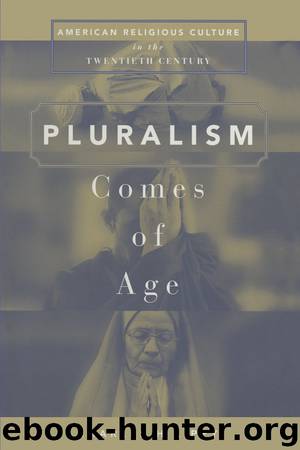Pluralism Comes of Age by Lippy Charles H

Author:Lippy, Charles H.
Language: eng
Format: epub
ISBN: 9781317462736
Publisher: Taylor & Francis Ltd
Opposing Government Policies on Religious Grounds
The civil rights movement of mid-century exemplifies another paradigm of the interaction of religion and society. Not only does it powerfully demonstrate the first paradigm—use of the legislative process to achieve political-religious ends—it also highlights a second—the active opposition to established government policy on religious and moral grounds. The United States entered the twentieth century a nation where racial segregation enjoyed legal sanction, for in Plessy v. Ferguson (1896), the Supreme Court ruled that providing “separate but equal” public facilities based on race did not violate the United States Constitution.19 In many states, particularly those of the former Confederacy, poll taxes and other tests reduced the percentage of African-American citizens registered to vote from what it was during Reconstruction. Segregation effectively created two nations, one with access to social and economic privilege and power, and one, with only a few exceptions, denied access to social and economic privilege and power. Even the Social Gospel movement, with its passion for the rights of labor and the quality of life of the working class, generally failed to address segregation and the immorality of a social system that marginalized one race.20 Early in the century, some prominent African Americans urged accommodation to racist culture, hoping that gradual improvement in the educational and economic status of African Americans would whittle away at racism.21
The “great migration” of African Americans from the rural South to the more urban North in the opening decades of the century complicated the racial situation. They joined immigrants and thousands of Euro-Americans seeking economic advancement in the cities. During the era of World War I, racial tension was almost the order of the day in some urban centers.22 The Great Depression displaced some, but not all ofthat undercurrent of racial tension with the sheer struggle for survival.
The turning point came only after World War II. During the war, African Americans had volunteered or been drafted for military service as had others. But the armed forces remained racially segregated. In 1948 President Harry Truman issued an executive order desegregating the American military.23 Six years later the United States Supreme Court, in Brown v. Board of Education, reversed the decision made in Plessy v. Ferguson fifty-eight years earlier, proclaiming the policy of “separate but equal” unconstitutional, for separate had never meant equal.24
Resistance to desegregation was widespread and often violent, yet the momentum initiated by Brown v. Board of Education could not be halted. The churches were at the center, though not all leadership for the civil rights movement came from the churches, particularly in the early days. The most-well known religious advocate of resistance through peaceful means and opposition to unjust policy was one nurtured in the church, the Rev. Martin Luther King, Jr.25 King offered his church and his leadership to a boycott of the public transportation system in Montgomery, Alabama, after Rosa Parks, an African-American woman, refused to follow segregated practice by standing in the rear of the bus when there were seats, by local law reserved for whites, available in the front.
Download
This site does not store any files on its server. We only index and link to content provided by other sites. Please contact the content providers to delete copyright contents if any and email us, we'll remove relevant links or contents immediately.
Resisting Happiness by Matthew Kelly(3197)
The Social Psychology of Inequality by Unknown(2770)
Designing Your Life by Bill Burnett(2603)
Day by Elie Wiesel(2596)
The Giving Tree by Shel Silverstein(2174)
Angels of God: The Bible, the Church and the Heavenly Hosts by Mike Aquilina(1870)
Human Design by Chetan Parkyn(1859)
The Supreme Gift by Paulo Coelho(1799)
Jesus of Nazareth by Joseph Ratzinger(1709)
Augustine: Conversions to Confessions by Robin Lane Fox(1688)
Hostage to the Devil by Malachi Martin(1676)
7 Secrets of Divine Mercy by Vinny Flynn(1620)
Dark Mysteries of the Vatican by H. Paul Jeffers(1607)
The Vatican Pimpernel by Brian Fleming(1587)
St. Thomas Aquinas by G. K. Chesterton(1557)
Saints & Angels by Doreen Virtue(1530)
The Ratline by Philippe Sands(1425)
My Daily Catholic Bible, NABRE by Thigpen Edited by Dr. Paul(1418)
Called to Life by Jacques Philippe(1410)
